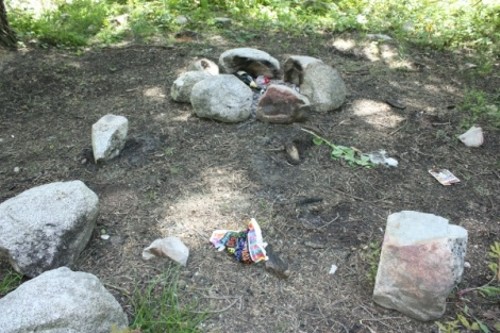I found the Quarry Trail at the mouth of Little Cottonwood Canyon about 15 years ago. At that time, it was a fantastic mountain-bike experience: mostly single track; smooth, hard-packed dirt; challenging twists and turns through the trees and, at less than three miles long, short enough for a quick ride.
But soon it was discovered by crowds of other bikers. They rode when it was wet, leaving deep ruts in the dirt. The many wheels eroded the trail, revealing sharp, flat-tire-making rocks. Riders began going around the ruts and rocks, widening the trail, killing brave, small saplings trying to survive. In an effort to improve the worn-down trail, gravel was used to fill it back up—but the gravel, an ecological stranger to the area, killed off the beautiful wildflowers that used to line the trail in late summer. Other bikers and hikers carved their own new paths through woods, attracting even more trail users.
The trail is still nice to ride, but nowhere near as nice as it was before it was loved to death by hordes of users.
This year, nearly every mountain trail is in danger of being loved to death by bikers, hikers and horses because the ground is still saturated from all the rain and snow this winter and spring. Rick Vallejos, recreation staff officer for the Ogden Ranger District, says, “The [trail] damage in spring is ... kind of tragic. We spend thousands trying to fix it. When people, particularly horses, leave deep tracks and ruts in trails, it’s 50 times worse than a mountain bike. When a deep hole is left by a horse hoof, no one wants to ride over it. When you put a track on a wet trail, it dries like concrete. When the dry material is powderized, it blows away, leaving only the rock—which makes lousy trails.”
It’s so bad that the Ogden Ranger District has closed all the trails around the Snowbasin area. It’s the first time since those trails have been built that they’ve had to be closed. The trails are actually blocked with posts and 2-by-6s.
He says that as snow starts to melt, there may be a snowdrift right in the middle of the trail. “When 100 people go around it, now we have a new trail, which we don’t want. People have to be sensitive to that.”
Vallejos suggests treating mountain trails like you own them—which, in many cases, as a citizen, you do. He also suggests finding alternative places to go, because it’s not even the snow that’s the problem anymore—it’s the rain. Mountain trails won’t be dry and ride-ready until at least the middle of July, maybe later. Even if most of a trail is dry, there are still wet spots.
You may think, “Hey, it’s just me going for a hike. How much damage can that cause?” But Vallejos says, “If you’re up on the trails, so are a hundred other people. Maybe you won’t do the damage, but you plus a hundred others will. Keep looking back over where you’ve gone. If you notice that your feet or wheels or horses’ hooves are leaving any impact on the trail, turn around and go back.”
The advice isn’t just for this extremely wet season. Knowing that bike-wheel ruts and footstep depressions, even baby-stroller wheels, will mark up a wet trail, avoid going onto mountain-wilderness trails for at least a week after a rain. Trails offer a path of less resistance rather than soil more covered with brush and plants, leaving the bare trail wetter than surrounding areas and more easily roughed up. But don’t ever go off the trail into brushy areas; you’ll damage or kill the small plants that prevent soil erosion and, worse, start new trails that others will follow and extend.
If you want to protect the natural environment for all users, and at the same time you feel anger at the ATV riders who cut their own trails through delicate desert environments, then be consistent: Don’t do the same thing with nonmotorized travel in the wilderness. A trail that has been loved to death may not actually die, but when it’s eroded to become rockier—scarred with ruts, and widened to avoid those ruts and exposed rocks—it becomes far less pleasant to ride. What dies is the trail’s character and nature, its unique qualities and delights. If you really love biking or hiking mountain trails, show your love by keeping them intact.
Speaking of...
-
Pottermore
Inside Harry Potter online world
- Sep 13, 2011
-
Lehi Police Cover-ups
City prosecutor alleges police chief helps his friends.
- May 18, 2010
-
Daniel Tosh
SATURDAY 3.6
- Mar 3, 2010
- More »
More by Wina Sturgeon
-
Conquer the Superpipe
Some advice to help you take the plunge
- Jan 8, 2013
-
Park City Shortcuts
Bypass the traffic and be on your way
- Dec 24, 2012
-
Ride the Terrain Park
Start learning or polish your skills
- Dec 11, 2012
- More »



